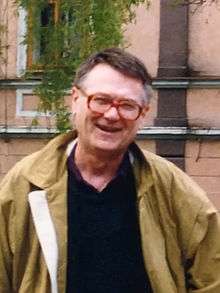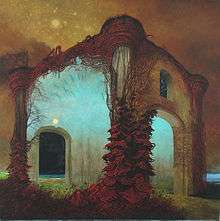Zdzisław Beksiński
| Zdzisław Beksiński | |
|---|---|
 Polish painter Zdzisław Beksiński | |
| Born |
February 24, 1929 Sanok, Poland |
| Died |
February 21, 2005 (aged 75) Warsaw, Poland |
| Nationality | Polish |
| Known for | Painting, Sculpture, Photography |
| Awards | Order of Polonia Restituta |
| Website |
www |
Zdzisław Beksiński (pronounced [ˈzd͡ʑiswaf bɛkˈɕiɲskʲi]; 24 February 1929 – 21 February 2005) was a Polish painter, photographer and sculptor, specializing in the field of dystopian surrealism. Beksiński did his paintings and drawings in what he called either a 'Baroque' or a 'Gothic' manner. His creations were made mainly in two periods. The first period of work is generally considered to contain expressionistic color, with a strong style of "utopian realism" and surreal architecture, like a doomsday scenario. The second period contained more abstract style, with the main features of formalism.[1]
Beksiński was stabbed to death at his Warsaw apartment in February 2005 by a 19-year-old acquaintance from Wołomin, reportedly because he refused to lend the teenager any money and threatened him further.[2]
Life

Zdzisław Beksiński was born in Sanok, southern Poland. He studied architecture in Kraków. In 1955, he completed his studies and returned to Sanok, working as a construction site supervisor, but found out he did not enjoy it. During this period, he had an interest in montage photography, sculpting and painting. When he first started his sculpting, he would often use his construction site materials for his medium. His early photography would be a precursor to his later paintings often depicting peculiar wrinkles, desolate landscapes and still-life faces on rough surfaces. His paintings often depict anxiety, such as torn doll faces, faces erased or obscured by bandages wrapped around the portrait. His main focus was on abstract painting, although it seems his works in the 1960s were inspired by Surrealism.[1]
Painting and drawing


Beksiński had no formal training as an artist. He was a graduate of the Faculty of Architecture at the Kraków Polytechnic with M.Sc. received in 1952.[2] His paintings were mainly created using oil paint on hardboard panels which he personally prepared, although he also experimented with acrylic paints. He abhorred silence, and always listened to classical music while painting. Although he loved classical music, Beksinski appreciated rock music as well.
Fantastic Realism
A prestigious exhibition in Warsaw in 1964 proved to be his first major success, as all his paintings were sold.
Beksiński threw himself into painting with a passion, and worked constantly (always to the strains of classical music). He soon became the leading figure in contemporary Polish art. In the late 1960s, Beksiński entered what he himself called his "fantastic period", which lasted up to the mid-1980s. This is his best-known period, during which he created very disturbing images, showing a gloomy, surrealistic environment with very detailed scenes of death, decay, landscapes filled with skeletons, deformed figures and deserts. These paintings were quite detailed, painted with his trademark precision. At the time, Beksiński claimed, "I wish to paint in such a manner as if I were photographing dreams".
Despite the grim overtones, Beksiński claimed some of his works were misunderstood; in his opinion, they were rather optimistic or even humorous. For the most part, though, Beksiński was adamant that even he did not know the meaning of his artworks and was uninterested in possible interpretations; in keeping with this, he refused to provide titles for any of his drawings or paintings. Before moving to Warsaw in 1977, he burned a selection of his works in his own backyard, without leaving any documentation on them. He later claimed that some of those works were "too personal", while others were unsatisfactory, and he didn't want people to see them.
Later work
The 1980s marked a transitory period for Beksiński. During this time, his works became more popular in France due to the endeavors of Piotr Dmochowski, and he achieved significant popularity in Western Europe, the United States and Japan. His art in the late 1980s and early 1990s focused on monumental or sculpture-like images rendered in a restricted (and often subdued) color palette, including a series of crosses. Paintings in these style, which often appear to have been sketched densely in colored lines, were much less lavish than those known from his "fantastic period", but just as powerful. In 1994, Beksiński explained "I'm going in the direction of a greater simplification of the background, and at the same time a considerable degree of deformation in the figures, which are being painted without what's known as naturalistic light and shadow. What I'm after is for it to be obvious at first sight that this is a painting I made".
In the latter part of the 1990s, he discovered computers, the Internet, digital photography and photomanipulation, a medium that he focused on until his death.
Family tragedies and death
The late 1990s were a very tragic time for Beksiński. His wife, Zofia, died in 1998; a year later, on Christmas Eve 1999, his son Tomasz (a popular radio presenter, music journalist and movie translator) committed suicide. Beksiński discovered his son's body. Unable to come to terms with his son's death, he kept an envelope "For Tomek in case I kick the bucket" pinned to his wall. Director Jan P. Matuszyński’s debut feature will focus on the relationship between the painter Zdzisław Beksiński and his son Tomasz Beksiński. The movie's release is planned for 2016.[3]

On 21 February 2005, Beksiński was found dead in his flat in Warsaw with 17 stab wounds on his body; two of the wounds were determined to have been fatal. Robert Kupiec (the teenage son of his longtime caretaker), who later pleaded guilty, and a friend were arrested shortly after the crime. On 9 November 2006 Robert Kupiec was sentenced to 25 years in prison, and his accomplice, Łukasz Kupiec, to 5 years by the court of Warsaw. Before his death, Beksiński refused to loan Robert Kupiec a few hundred złoty (approximately $100).
Personality
Although Beksiński's art was often grim, he himself was known to be a pleasant person who took enjoyment from conversation and had a keen sense of humor. He was modest and somewhat shy, avoiding public events such as the openings of his own exhibitions. He credited music as his main source of inspiration. He claimed not to be much influenced by literature, cinema or the work of other artists, and almost never visited museums or exhibitions. Beksiński avoided concrete analysis of the content of his work, saying "I cannot conceive of a sensible statement on painting". He was especially dismissive of those who sought or offered simple answers to what his work 'meant'.
Artistic legacy
The town of Sanok, Poland, houses a museum dedicated to Beksiński. A Beksiński museum housing 50 paintings and 120 drawings from the Dmochowski collection (who owns the biggest private collection of Beksiński's art[4]), opened in 2006 in the City Art Gallery of Częstochowa, Poland. On 18 May 2012 with the participation of Minister of Regional Development Elżbieta Bieńkowska and others took place ceremonial opening of The New Gallery of Zdzisław Beksiński in the rebuilt wing of the castle. On 19 May 2012 The New Gallery has been opened for the public. A 'Beksiński cross', in the characteristic T-shape frequently employed by the artist, was installed for Burning Man.
In other media

The unblack metal band Antestor used "The Trumpeter" as cover art for their album Omen.[5] Antestor explained that they chose "The Trumpeter" because "Our music represents the more broken and monster-like feelings of our humanity, like the apparition in this picture."[6]
References
- 1 2 Krzysztof Jurecki (August 2004), Zdzisław Beksiński at Culture.pl, Museum of Art in Łódź. Translated by Marek Kępa, February 2012.
- 1 2 Polska Agencja Prasowa (29 November 2010), Morderstwo malarza Zdzisława Beksińskiego. Zabójca Beksińskiego posiedzi 25 lat - odwołanie oddalone. Za dziennikiem Super Express z dn. 23.02.2005.
- ↑ Ostatnia Rodzina/Last Family, Film New Europe, http://www.filmneweurope.com/news/poland-news/item/110032-production-jan-p-matuszewski-preps-a-biopic-on-painter-zdzislaw-beksinski
- ↑ Sny Beksińskiego November 2015.
- ↑ Synn, Andy (January 15, 2013). "Antestor: "Omen"". No Clean Singing. Islander. Retrieved April 13, 2015.
- ↑ Beck, Chris (February 2013). "Antestor – Taking Care of Unfinished Business" (PDF). HM. Doug Van Pelt (163): 46–49. Retrieved April 11, 2015.
Sources
- Cowan, J. (Ed.) 2006: The Fantastic Art of Beksinski - Zdzislaw Beksinski: 1929-2005, 3rd edn., Galerie Morpheus International, Las Vegas. ISBN 1-883398-38-X.
- Dmochowski, A. & P. 1991: Beksiński - Photographies, Dessins, Sculptures, Peintures, 2nd edn., API Publishing (France?).
- Dmochowski, A. & P. 1991: Beksiński - Peintures et Dessins 1987-1991, 1st edn., API Publishing (France?).
- Gazeta Wyborcza, an interview with Zdzisław Beksiński
- Kulakowska-Lis, J. (Ed.) 2005: Beksiński 1, 3rd edn.; with introduction by Tomasz Gryglewicz. Bosz Art, Poland. ISBN 83-87730-11-4.
- Kulakowska-Lis, J. (Ed.) 2005: Beksiński 2, 2nd edn.; with introduction by Wieslaw Banach. Bosz Art, Poland. ISBN 83-87730-42-4.
External links
| Wikimedia Commons has media related to Zdzisław Beksiński. |
- Official Site presented by Belvedere Gallery
- Zdzisław Beksiński at Culture.pl
- Zdzisław Beksiński virtual museum (Polish) (German) (English) (French)
- Zdzisław Beksiński gallery (Polish)
- An Artist does not live anymore. In memoriam for Zdzisław Beksiński by a film director Piotr Andrejew, KINO, no. 6/2005 (Polish)
- Dark Art: Beksiński gallery